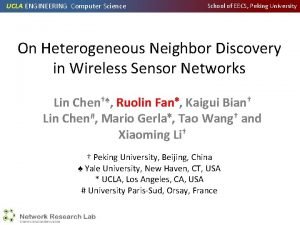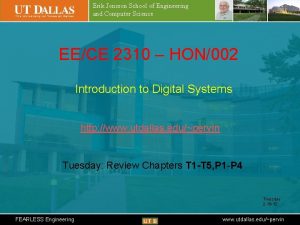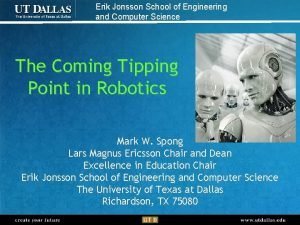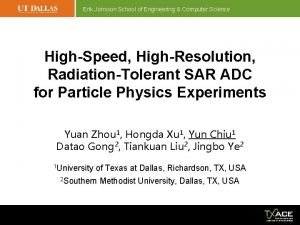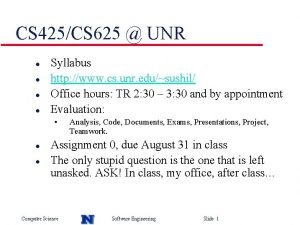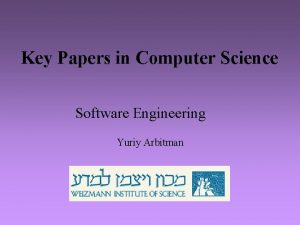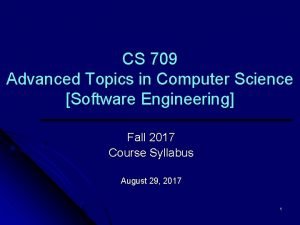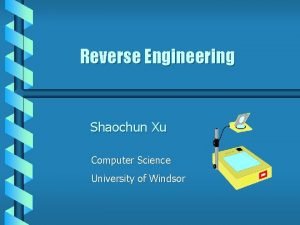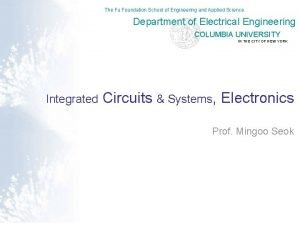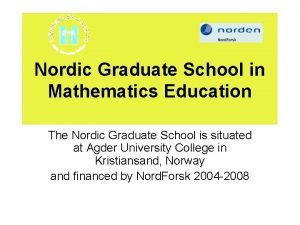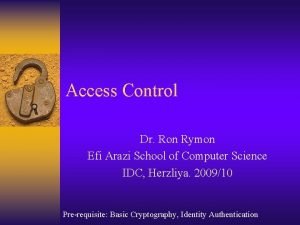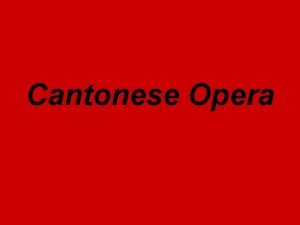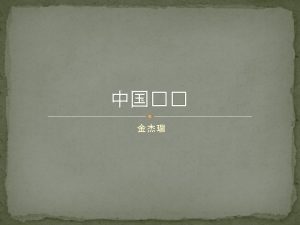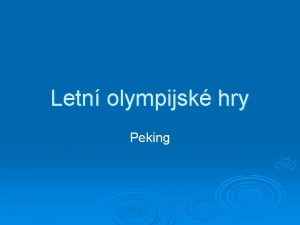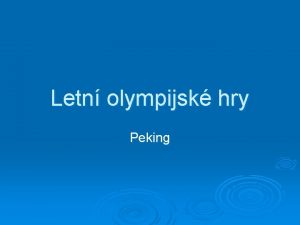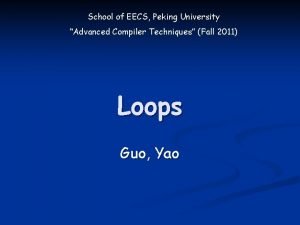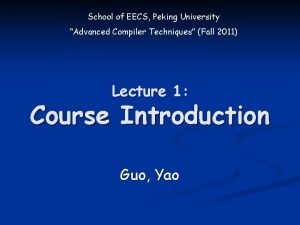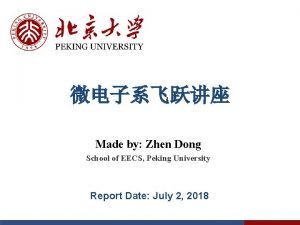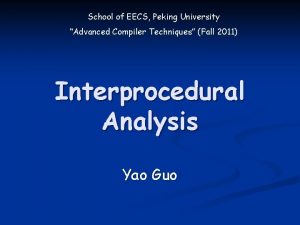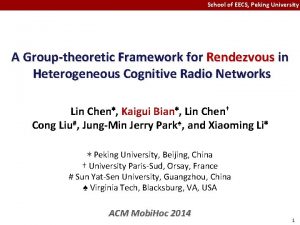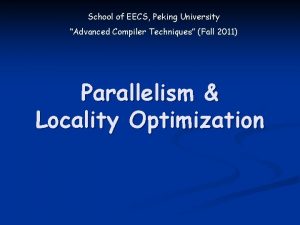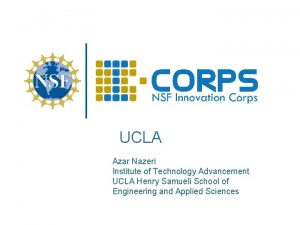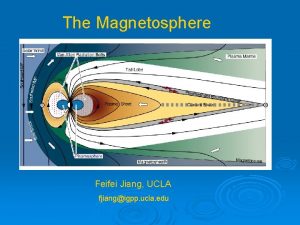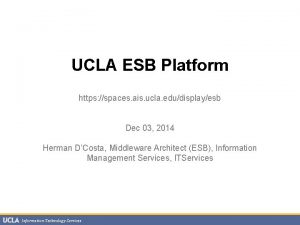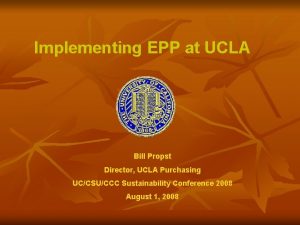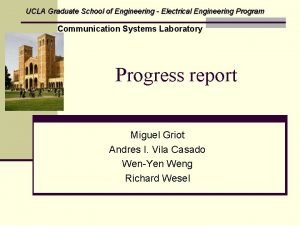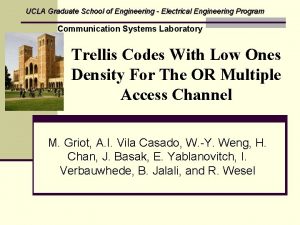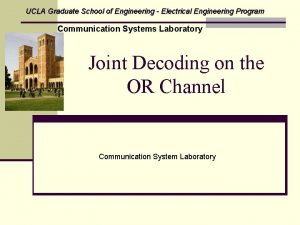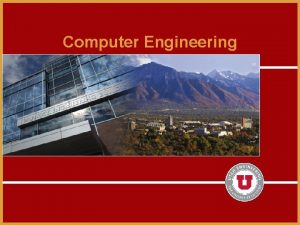UCLA ENGINEERING Computer Science School of EECS Peking

























- Slides: 25

UCLA ENGINEERING Computer Science School of EECS, Peking University On Heterogeneous Neighbor Discovery in Wireless Sensor Networks Lin Chen†♠, Ruolin Fan∗, Kaigui Bian† Lin Chen#, Mario Gerla∗, Tao Wang† and Xiaoming Li† † Peking University, Beijing, China ♠ Yale University, New Haven, CT, USA * UCLA, Los Angeles, CA, USA # University Paris-Sud, Orsay, France

UCLA ENGINEERING Computer Science School of EECS, Peking University A BRIEF INTRODUCTION TO NEIGHBOR DISCOVERY

UCLA ENGINEERING Computer Science School of EECS, Peking University Find the Neighbors to Form a Network

UCLA ENGINEERING Computer Science School of EECS, Peking University Power Conservation Keep radios off, turn on periodically

UCLA ENGINEERING Computer Science School of EECS, Peking University ND Protocol Determines the Pattern by Which Each Radio Turns ON or OFF Period = 6 Node A (6) 0 0 0 0 0 1 … Node B (2, 9) 0 1 0 0 0 1 … Period = 9 Duty Cycle: Percentage of 1 period in which a sensor/radio is active Node A’s DC = 1/6; Node B’s DC = 2/9

UCLA ENGINEERING Computer Science School of EECS, Peking University ND Protocol Determines the Pattern by Which Each Radio Turns ON or OFF Node A (6) Node B (2, 9) 0 0 0 1 0 0 0 0 0 1 1 0 0 0 0 1 … A viable neighbor discovery protocol must either implement clock synchronization or be robust in the face of clock drifts …

UCLA ENGINEERING Computer Science School of EECS, Peking University Goals 1. Guarantee neighbor discovery within a reasonable time frame 2. Minimize the number of time slots for which the node is awake to save energy 3. Match the nodes’ awake-sleep schedules with their heterogeneous battery duty cycles as closely as possible (ie. Finer duty cycle granularity)

UCLA ENGINEERING Computer Science School of EECS, Peking University SOME EXISTING ND PROTOCOLS

UCLA ENGINEERING Computer Science School of EECS, Peking University ND Protocol Types • Probabilistic Protocols § Exploits the birthday paradox § Non-deterministic: No upper bound on discovery latency • Quorum Based Protocols § Exploits the geometry of a 2 -D array • Co-primality Based Protocols § Exploits the Chinese Remainder Theorem (CRT)

UCLA ENGINEERING Computer Science School of EECS, Peking University Quorum ND Protocols 1 1 1 1 1 Period = 16 Duty Cycle = 7/16 • Arrange time slots into a matrix formation • Choose 1 row and column as the “on” slots § This ensures that nodes operating on the same duty cycle (ie. Homogeneous nodes) will discover each other within bounded time • Latest development: Searchlight

UCLA ENGINEERING Computer Science School of EECS, Peking University Co-Prime ND Protocols Theorem: A Co-primality based neighbor discovery protocol guarantees discovery for any two nodes for any amount of clock drifts if the associated integer sets of the nodes in this network satisfy the co-prime pair property, with the worst-case discovery delay bounded by the product of the two smallest co-prime numbers, one from each set

UCLA ENGINEERING Computer Science School of EECS, Peking University Co-Prime ND Protocols • Example from theorem: 2 nodes with wakeup schedules of 3 and 2, respectively A: 3 1 0 0 B: 2 01 10 Time drift by 1 time slot • In reality, each node chooses 2 different numbers and combine their wake-up slots § Solves the problem of 2 nodes choosing the same number • Latest development: Disco (only choose prime numbers)

UCLA ENGINEERING Computer Science School of EECS, Peking University HEDIS (QUORUM) VS TODIS (COPRIME)

UCLA ENGINEERING Computer Science School of EECS, Peking University HEDIS - The Optimized Quorum Protocol • HEterogeneous DIScovery Protocol • Asynchronous periodic slot-based protocol • Uses n x (n-1) time slots § § n depends upon the desired duty cycle δ n ≈ 2/δ Duty cycle granularity: 2/n The n’s must be of the same parity to guarantee discovery Ø Protocol dictates all odd or all even § • Example: even protocol, δ = 7% = 7/100 2/(7/100) = 200/7 ≈ 28 = n In this case, 2/n = 2/28 ≈ 0. 071 Radio on for: § § Slots numbered n x i Slots numbered (n+1) x i, where i = 0, 1, 2, …, n-2

UCLA ENGINEERING Computer Science School of EECS, Peking University HEDIS Theorem: HEDIS guarantees neighbor discovery within bounded latency for any two nodes with the same-parity parameters n and m, given any amount of clock drift between their schedules. The average discovery latency is O(nm)

UCLA ENGINEERING Computer Science School of EECS, Peking University HEDIS Example n 1 = 4: 4 x 3 slots n 2 = 6: 6 x 5 slots 0 1 2 3 4 5 6 7 8 9 10 11 12 13 14 15 16 17 18 19 20 21 22 23 24 25 26 27 28 29 0 1 2 3 4 5 6 7 8 9 10 11 12 13 14 0 … 15 … 23 24 25 26 27 28 29

UCLA ENGINEERING Computer Science School of EECS, Peking University TODIS – The Optimized Co-Prime Protocol • Triple-Odd DIScovery Protocol • Duty cycle granularity too high if only prime numbers are chosen to ensure co-primality (DISCO) • Observation: all prime numbers (except for 2) are odd § Odd integers are likely to be co-prime • Each node chooses consecutive odd integers § Example: Na = {33, 35}; Nb = {5, 7} Øgcd(35, 5) = 5; gcd(35, 7) = 7 Øgcd(33, 5) = 1 => co-prime; gcd(33, 7) = 1 => co-prime

UCLA ENGINEERING Computer Science School of EECS, Peking University TODIS Continued • Two consecutive odd integers does not guarantee co-primality for many number combinations less than 100: {33, 35}, {75, 77} § All possible pairs yield gcd > 1 • Three consecutive odd integers will do the trick § Smallest counterexample: {1600023, 1600025, 1600027} and {2046915, 2046917, 2046919} • Supports duty cycle of 3(n 2 -n-1)/(n(n 2 -4)) ≈ 3/n

UCLA ENGINEERING Computer Science School of EECS, Peking University PERFORMANCE EVALUATION

UCLA ENGINEERING Computer Science School of EECS, Peking University A Comparison of ND Protocols Protocol Name Parameter Restriction Average Discovery Delay Supported Duty Cycles DISCO Prime p 1, p 2, p 3, p 4 O(min{p 1 p 3, p 1 p 4, p 2 p 3, p 2 p 4}) 1/p 1 + 1/p 2 U-Connect Prime p 1, p 2 O(p 1 p 2) (3 p 1+1)/2 p 12 Searchlight Power multiples of t 1, t 2 O(t 1 t 2) 2/t 12 HEDIS Same parity n, m O(nm) 2/n TODIS Odd n, m O(nm) 3(n 2 -n-1)/(n(n 2 -4)) ≈ 3/n

UCLA ENGINEERING Computer Science School of EECS, Peking University Duty Cycle Matching - Errors Small Duty Cycles: 1, 1/2, 1/3, …, 1/100 Large Duty Cycles: 0%, 1% 2%, 3%, …, 100%

UCLA ENGINEERING Computer Science School of EECS, Peking University CDFs of Discovery Latency

UCLA ENGINEERING Computer Science CONCLUSION School of EECS, Peking University

UCLA ENGINEERING Computer Science School of EECS, Peking University Conclusion • We explore the current two main approaches of designing a heterogeneous ND protocol: quorum and co-primality • We design HEDIS and TODIS, a quorum and coprimality protocol respectively • Both can match battery duty cycles at a high granularity (2/n and ∼ 3/n) • HEDIS performs better than TODIS in discovery latency

UCLA ENGINEERING Computer Science Thank You! Questions? School of EECS, Peking University
 Eecs ucla
Eecs ucla Erik jonsson school of engineering and computer science
Erik jonsson school of engineering and computer science Erik jonsson school of engineering and computer science
Erik jonsson school of engineering and computer science Utd erik jonsson school of engineering
Utd erik jonsson school of engineering Ucla systems engineering
Ucla systems engineering System procurement process in software engineering
System procurement process in software engineering My favorite subject is science แปลว่า
My favorite subject is science แปลว่า Computer science vs software engineering
Computer science vs software engineering Ucf computer engineering
Ucf computer engineering Computer science and engineering unr
Computer science and engineering unr Computer science software engineering
Computer science software engineering Computer science software engineering
Computer science software engineering Reverse engineering computer science
Reverse engineering computer science Columbia university power electronics
Columbia university power electronics Graduate school of engineering science osaka university
Graduate school of engineering science osaka university Ucla school of nursing
Ucla school of nursing Ucla school of nursing acceptance rate
Ucla school of nursing acceptance rate Mark covin ucla
Mark covin ucla Welcome performance in school
Welcome performance in school Ucla graduate school
Ucla graduate school Nordic studies in mathematics education
Nordic studies in mathematics education Klipsch school of electrical and computer engineering
Klipsch school of electrical and computer engineering Efi arazi school of computer science
Efi arazi school of computer science Introduction cantonese
Introduction cantonese Purple stands for uprightness and cool headedness
Purple stands for uprightness and cool headedness Reka jangcekjang
Reka jangcekjang
